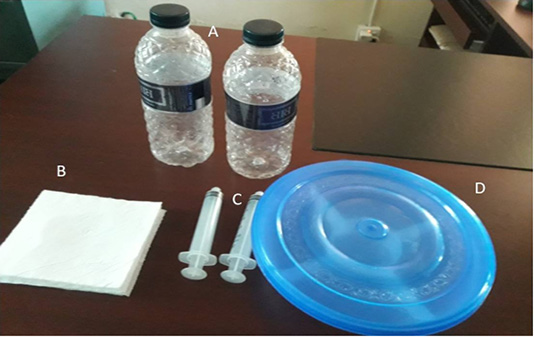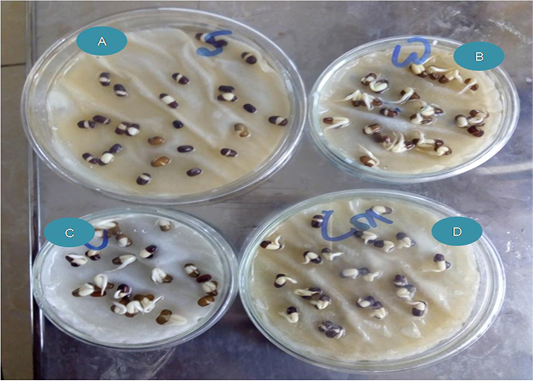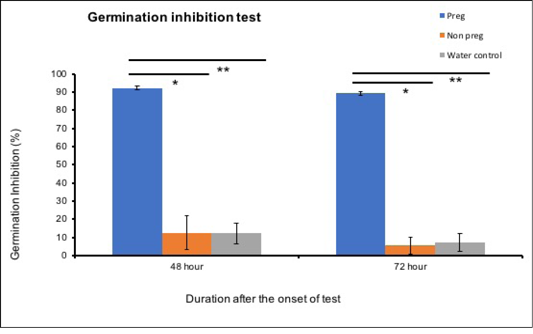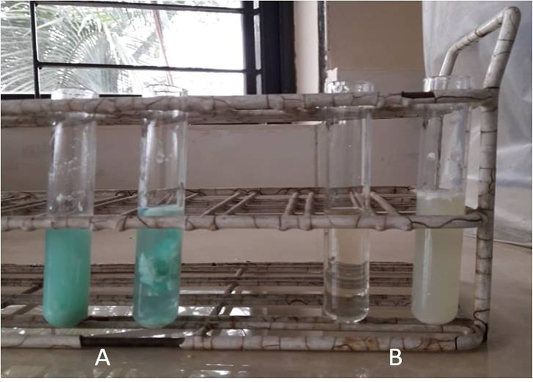Advances in Animal and Veterinary Sciences
Research Article
Evaluation of Three Non-Invasive Pregnancy Diagnosis Tests (Modified Seed Germination Inhibition Test, Urine Barium Chloride Test and Milk Copper Sulphate Test) in Buffalo
Seikh Masudur Rahman2, Shib Shankar Sahsa1*
1Patuakhali Science and Technology University, Bangladesh; 2Bangladesh Livestock Research Institute, Bangladesh.
Abstract | There is no cheap and useful tool for pregnancy diagnosis in buffalo reared in remote areas. The research aimed to standardize a modified seed germination inhibition assay for detection of pregnancy in buffalo for distant rearers, and evaluation of three non-invasive pregnancy diagnostic methods namely, seed germination inhibition assay, milk copper sulphate test and urine barium chloride test was also performed. The present study was conducted per rectally confirmed pregnant and non- pregnant milking buffaloes. For this, several modifications were made such as petridishes were replaced with spices tray, distilled water with tap water, blotting paper was replaced with tissue paper (facial or toilet) and use of sorghum seed (Syngenta®).The results were recorded on 3 hr, 24 hr, 48 hr and 72 hr of post setting. The urine of pregnant buffaloes showed significant inhibitory germination response in all stages of germination in this experiment as compared to the urine of non- pregnant buffaloes and water controls. The efficacies of actual true positive reaction for pregnancy and non -pregnancy status in buffaloes were 100%, each by seed germination inhibition test whereas, 76.67% and 93.33% respectively, by urine barium chloride test, and 83.34% and 86.66% respectively by milk copper sulphate test. Results report the simplified seed germination inhibition test as a very reliable, cheap and door step test for detection of pregnancy in buffaloes, but the duration of the test itself as a constraint.
Keywords | Buffalo, Efficacy, Pregnancy detection, Seed germination inhibition.
Received | July 14, 2020; Accepted | July 22, 2020; Published | September 05, 2020
*Correspondence | Shib Shankar Saha, Patuakhali Science and Technology University, Bangladesh; Email: [email protected]
Citation | Rahman SM, Saha SS (2020). Evaluation of three non-invasive pregnancy diagnosis tests (modified seed germination inhibition test, urine barium chloride test and milk copper sulphate test) in buffalo. Adv. Anim. Vet. Sci. 8(11): 1225-1231.
DOI | http://dx.doi.org/10.17582/journal.aavs/2020/8.11.1225.1231
ISSN (Online) | 2307-8316; ISSN (Print) | 2309-3331
Copyright © 2020 Saha and Rahman This is an open access article distributed under the Creative Commons Attribution License, which permits unrestricted use, distribution, and reproduction in any medium, provided the original work is properly cited.
Introduction
For profitable and sustainable husbandry practices, accurate pregnancy diagnosis in cattle and buffalo has paramount importance. Optimum reproduction of buffalo is impeded by its delayed maturity, silent heat, irregular estrous cycles, seasonal breeding, anoestrus and long calving intervals (Mondal et al., 2007; Guraya, 1997), and a lot of slunk buffalo calves are found in slaughter houses. To improve the reproductive performances, scientists have established and practised several pregnancy detection techniques such as rectal palpation, radiography, ultrasound technique, and an assay of hormones and rosette inhibition test for buffaloes (Pawshe and Purohit, 2013). All these techniques need trained skilled personnel and also sophisticated laboratory equipment and procedures, which are beyond farmers’ capacity. For these reasons, researchers are still working to find an economical, user friendly and door step technology for buffalo pregnancy detection. Punyakoti test, a seed germination inhibition test, was developed for pregnancy detection in human at ancient Egypt papyri, adopted by Veena and Narendranath (1993) with suitable modifications. Observing the germination inhibition percentage and reduced shoot length of wheat seeds early studies reported the techniques as a bioassay for pregnancy diagnosis in cattle and buffalo (Aswathnarayanappa et al., 2019; Rine et al., 2014; Skálová et al., 2017).
Different seeds have been used for the seed germination test, such as mung beans (Dilrukshi and Perera, 2012), green gram (Aswathnarayanappa et al., 2019), maize seed (Hussain et al., 2016) and wheat seeds (Krishna and Veena, 2009; Rine et al., 2014).The factors such as absicic acid, auxins, estrogen and progesterone of urine of pregnant animal might be responsible for inhibition of germination and shoot length growth in seeds (Veena and Narendranath, 1993). Abscisic acid (ABA), a plant hormone that causes seed dormancy in nature (Dilrukshi and Perera, 2012). The differences of ABA have been detected in the urine of pregnant cows at different concentrations compare to non- pregnant cows (Dilrukshi and Perera, 2012). Though, seed germination inhibition test is practised in many countries for detection of pregnancy in dairy animal, even one report on crossbred dairy cattle using wheat seeds in Bangladesh (Rine et al., 2014); but there is no published report of this technique in buffalo adaptive for remote farmers. Urine sampling by free catch is a non-invasive research technique that enables collection of urine without disturbing pregnant animal aids in pregnancy detection. Urine barium chloride test is an old test developed by a Russian scientist, who found that addition of a 1% solution of barium chloride (BaCl2) to urine of non-pregnant cows (Bos taurus) causes the creation of a white precipitate, whereas, no reaction was found in case of pregnant cows (Kubátová et al., 2016; Lalrintluanga and Dutta, 2009). Detection of the pregnant animal using copper sulphate is another non-invasive technique practiced by related personnel (Krishna and Veena, 2009; Pawshe and Purohit, 2013). For the development of an effective user friendly non -invasive technique for detection of buffalo pregnancies following objectives were selected:
Standardization of a modified seed germination inhibition assay for the detection of pregnancy in buffalo.
Comparative efficacies of three non-invasive pregnancy diagnosis assay namely modified seed germination inhibition assay, urine barium chloride assay and milk copper sulphate assay.
Materials and Methods
The research was conducted at Tarash upazila of Sirajganj district during the period from May 2019 to November 2019.
Seed Germination Inhibition Test
The seed germination inhibition test was performed using sorghum seeds, as explained by Veena and Narendranath (1993). In this experiment, commercially available sorghum seed (Syngenta®) was used to ensure better seed germination efficacy, and seed was purchased from a local market.All buffaloes (n=60) having similar body conditions were randomly selected from Tarash upazila of Sirajganj district that were fed well and maintained under good managerial conditions. Among 60 animals, thirty confirmed pregnant buffaloes and thirty confirmed non- pregnant buffaloes were used for seed germination inhibition test. The pregnancy status of each tested buffalo was confirmed per rectally at least 60 days of artificial insemination or natural service.
A parallel test was also conducted with distilled water samples, which served as a control to compare the results. The fresh urine samples were collected in clean dry containers while the buffaloes were naturally micturating early in the morning. In the case of pregnant buffaloes, urine was collected at 2 months to 5 months age of pregnancy. The samples were immediately transported to the regional station of Bangladesh Livestock Research Institute, Shahjadpur, Sirajganj of Bangladesh, wherein they were subjected to seed germination inhibition test within four to six hours of collection.
Firstly, the test was standardized with the traditional method using petri dishes, blotting paper and distilled water (Figure 1). Fifteen sorghum seeds were placed in a series of petri dishes. The urine sample of the test animal was diluted with distilled water in the ratio of 1:4. 15 ml of diluted urine sample was placed in a medium sized petri dish where the seeds were sufficiently soaked in it. The petri dishes were covered with clean and dry trays to preserve moisture and also to avoid possible contamination and other disturbances. All the petri dishes were kept at room temperature away from sunlight and the observations were recorded for the per cent of seed germination inhibition at3 hours post setting for imbibition, 24 hours post setting for root growth, 48 hours post setting for shoot growth, 72 hours post setting for leaves growth. A similar test was conducted with distilled water as a control. The germination inhibition per cent was calculated using the following formula:

Germination inhibition percent was compared among confirmed pregnant, confirmed non pregnant, water control.
To make the test more convenient for the farmers working in places fur away from the center of town, the test was performed with some modification as the petri-dishes were replaced by spices’ tray, blotting paper by facial or toilet tissue and distilled water by tape water (Figure 3) and data were recorded. For each buffalo, the test was conducted with a replica of four tests.

Figure 1: Materials used for modified seed germination inhibition test. (A) Used mineral water container (B) Toilet tissue paper (C) 10 ml syringe without needle for measuring urine (d) Spices tray
Comparative Efficacy Test Among Three Non -Invasive Pregnancy Detection Tests
The modified seed germination inhibition test’s effectiveness measured comparing the data of three non -invasive tests namely: seed germination inhibition assay, urine barium chloride test and milk copper sulphate test. For the comparative efficacy test, data from 30 per rectally confirmed pregnant and 15 non -pregnant milking buffaloes were taken. The efficacy tests were carried out in the laboratory of BLRI regional station, Sirajganj, Bangladesh. Barium chloride test was carried out as described before (Kubátová et al., 2016; Lalrintluanga and Dutta, 2009). In a test tube, 5 ml of urine was mixed with 5 ml of a 1% BaCl2solution. Then, the solution was agitated and left to stand for 5 min; after this, results were evaluated. When samples showed any degree of cloudiness or turbidity and after 5 min precipitation with the reagent, the test was concluded as negative (animals might be non-pregnant). When no reaction occurred in 5 min, the test was concluded as positive (animals might be pregnant).
Milk copper sulphate test was carried out as done before (Krishna and Veena, 2009). Briefly, this test consists of adding 10 ml of 3% CuSO4 to 0.5 to 1 ml milk in a test tube. The coagulation of milk indicates pregnancy, whereas if the milk remains homogeneous for several hours, then it is indicative of non-pregnancy.
Statistical Analysis
Statistical analysis for germination inhibition percentages of sorghum seeds in different groups at 48 hours and 72 hours of the setting of experiment was performed using one-way ANOVA with thepost hoc Tukey–Kramer test. Statistically significant differences betweengroups were accepted at P < 0.05. Relative efficacy of three non invasive tests was performed using the Cochran Q test.
Results
Modified Seed Germination Inhibition Test
To develop this modified seed germination inhibition test, at first the existing seed germination inhibition technique was established in the laboratory using petri dishes, blotting paper and distilled water (Figure 2). To make the test eligible for distant and remote buffalo farmers, several modifications were made as described in materials and methods (Figure 1). In this modified seed germination inhibition test, significant inhibitory germination response was found in all five stages of germination in this experiment as compared to urine from non-pregnant buffalo cows and water controls. The detection of pregnancy in buffalo with true pregnancy on rectal palpation with concomitant discoloration of germinating fluid/seeds was very evident. The difference was detectable in the naked eye. Statistically, urine of pregnant buffalo inhibited germination of sorghum seeds in all of the 30 cases, whereas, urine of non-pregnant animal and tap water control could not inhibit seed germination in all cases (Figure 3). When, the percentage of seed germination inhibition was analyzed, pregnant urine significantly (P<0.05) inhibited the germination potentiality of sorghum seeds at both 48 hr and 72 hr of the experiment (Figure 4). Urine of pregnant buffalo showed 92.2% inhibition at 48 hr of post setting and 89.25% at 72 hr of post setting of the experiment in spices tray (Figure 4). On the other hand, urine of non- pregnant buffalo and water control showed 12.59% and 12.22% at 48 hr, and 5.55% and 7.03% at 72 hr of post setting of the experiment (Figure 4).

Figure 2: Seed germination inhibition test in the conventional method. Picture shows the germination level at 72 hours setting of the experiment. A. Urine collected from pregnant buffalo confirmed through rectal palpation, B. Tap water control, C. Distilled water control, D. Urine collected from non- pregnant buffalo.
Table 1: Relative efficacy of different non- invasive pregnancy detection tests in buffaloes.
| Category | Confirmed pregnant | Confirmed non pregnant | ||||
|
Seed germination test (n=30) |
Urine barium chloride test (n=30) |
Milk copper sulphate test(n=30) | Seed germination test (n=30) | Urine barium chloride test (n=15) | Milk copper sulphate test (n=15) | |
| True positive |
30 (100%) |
23 (76.67%) |
25 (83.34% ) |
30 (100%) |
14 (93.33%) |
13 (86.66%) |
| False negative |
00 (100%) |
7 (23.33%) |
5 (16.66%) |
00 (100%) |
1 (6.67%) |
2 (13.34%) |

Figure 3: Seed germination inhibition test with some modifications. Pictures show the germination level at different time frame of the experiment. Four separate pictures represent different time points such as, (A) 3hr after setting (B) 24 hr after setting (C) 48 hr after setting (D) 72 hr after setting. One picture expresses four distinct experiment using different samples, (W) Tap water control (S1), Urine collected from pregnant buffaloes confirmed through rectal palpation (NP), Urine collected from non-pregnant buffaloes (S2), Urine collected from pregnant buffalo confirmed through rectal palpation of same animal S1.
Comparative Efficacy Test of Seed Germination Test with Urine Barium Chloride Test and Milk Copper Sulphate Test for Detection of Pregnancy in Buffaloes
Urine barium chloride test (Cuboni reaction) for pregnancy detection: Urine barium chloride test is a non- invasive chemical test used for detection in pregnancy in different animals such as in cow and mare with varying degree of accuracy. Positive reaction (pregnancy positive) is indicated as no reaction within 5 minute and negative reaction (pregnancy negative) is indicated by the appearance of cloudiness or turbidity with a degree of precipitation within 5 min of test reaction (Figure 5). Here, pregnant buffalo showed 76.67% positive reaction to this test and 23.33% negative reaction, though all experimentally used buffaloes were per rectally confirmed as pregnant (Table 1). Whereas, per-rectally confirmed non-pregnant buffalo showed 93.34% positive reaction and 6.66% negative reaction (Table 1).

Figure 4: Germination inhibition percentages of sorghum seeds in different groups at 48 hours and 72 hours of the setting of modified seed germination inhibition experiment. The data represent the averages from quadruplicate samples based on thirty (30) identical experiments, and the error bars denote the standard deviations. Significant differences were accepted at P <0.05. Here * indicates significant differences between urine of pregnant animal and urine of non-pregnant animal, and ** indicates significant differences between urine of pregnant animal and water control.
Milk Copper Sulphate Test for Pregnancy Detection
Milk copper sulphate test is another non- invasive test used in pregnancy detection for many years. In this test, milk of pregnant animal creates coagulation, whereas milk of non-pregnant animal does not produce such type of reaction as it remains homogenous for several hours (Figure 5). Milk of pregnant buffalo showed 83.34% positive reaction and 16.66% negative reaction; on the other hand, non-pregnant buffalo milk showed 86.66% positive reaction and 13.34% negative reaction (Table 1).

Figure 5: Detection of pregnancy using the chemical method. (A) Left two tubes indicate positive and negative results of milk copper sulphate test (b) Right two tubes indicate positive and negative results of urine barium chloride test.
Comparative Efficacy Test of Three Non-Invasive Tests
The efficacy of modified seed germination inhibition assay was compared with the other two non- invasive tests namely urine barium chloride test and milk copper sulphate test using Cochran’s Q test. Among three non -invasive pregnancy detection kit, modified seed germination inhibition test showed significantly (P≤ 0.05) higher level of detection proficiency result than urine barium chloride test and milk copper sulphate test in case of pregnant animal (Table 1). Whereas in case of non- pregnant animal, modified seed germination inhibition test showed better results than others, though the data was not statistically significant. The results indicated that the efficacies of true positive reaction for pregnancy and non -pregnancy status in buffaloes were 100 per cent, each by seed germination test whereas, 76.67% and 93.33% respectively, by urine barium chloride test, and 83.34% and 86.66% by milk copper sulphate test (Table 1).
Discussion
The non- invasive pregnancy diagnosis method might be the right choice for the remote farmers as it requires less expertise, fewer equipment and easy techniques. This study develops a simplified seed germination inhibition test suited for remote farmers compared the data with two other non-invasive pregnancy detection tests.
Pregnancy detection observing germination inhibition percentage and reduced shoot length is practised since many years in large ruminant (Aswathnarayanappa et al., 2019; Rine et al., 2014; Skálová et al., 2017). Researchers’ used different seeds such as mung beans, green gram, maize seed and wheat seeds for seed germination inhibition assay (Aswathnarayanappa et al., 2019; Dilrukshi and Perera 2012; Hussain et al., 2016; Krishna and Veena, 2009; Rine et al., 2014). Germination potential of different seed varies, in this modified seed germination assay, commercial sorghum seed (Syngenta®) was used having 75% germination potentiality.
For this study, urine was diluted as 1:4 solutions with water. For seed germination assay, several researchers made a trial with various dilution volumes and found 1:4 dilutions suitable for this seed germination inhibition assay (Aswathnarayanappa et al., 2019; Dilrukshi and Perera, 2012; Hussain et al., 2016; Skálová et al., 2017). After setting the experiment in spices tray, it was kept at room temperature and observations were made at different periods, 3 hours for imbibition, 24 hours for root growth, 48 hours for shoot growth, 72 hours for leaves growth.
In this modified seed germination inhibition test, significant inhibitory germination response was found in all five stages of germination in case of urine of pregnant buffalo as compared to the urine of non-pregnant buffalo cows and water controls. Pregnancy detection in buffalo with true pregnancy on rectal palpation with concomitant discoloration of germinating fluid/seeds was very evident. The difference was easily detectable in the naked eye. Statistically, urine of pregnant buffalo inhibits germination of sorghum seeds in all of the 30 cases, whereas, urine of non-pregnant animal and tap water control could not inhibit seed germination in all cases (Figure 3 & 4). When the percentage of seed germination inhibition was analyzed, pregnant urine significantly (P<0.05) inhibits the germination potentiality of sorghum seeds at both 48 hr and 72 hr of the experiment (Figure 4). Urine of pregnant buffaloes showed 92.2% inhibition at 48 hr of post setting and 89.25% at 72 hr of post setting of the experiment in spices tray (Figure 4). On the other hand, urine of non- pregnant buffalo and water control showed 12.59% and 12.22% at 48 hr, and 5.55% and 7.03% at 72 hr of post of experiment (Figure 4). Similar, increased mean seed germination inhibition was observed in pregnant cattle and buffalo by Aswathnarayanappa et al. (2019), Dilrukshi and Perera (2012), Hussain et al. (2016), Krishna and Veena (2009), Narayana et al. (2010), Rine et al. (2014) and Skálová et al. (2017).
The inhibition of seed germination of this study could be attributed to the increased level of abscisic acid (Dilrukshi and Perera, 2012). A lower urinary pH in pregnant females can be caused by the presence of ABA. In 1:4 dilutions of urine, the concentration of abscisic acid leads to an increase the dormancy of seed by water logging activity (Hussain et al., 2016). Excreted hormone metabolites in urine such as oestrogen and progesterone of pregnant animal might affect the seed germination; however, in one experiment it is proved that oestrogen and progesterone in their natural form do not have any influence in seed germination and shoot length (Nirmala et al., 2008).
The efficacy of this newly developed modified seed germination inhibition assay was compared with the other two non-invasive pregnancy diagnosis tests such as urine barium chloride test and milk copper sulphate test. From this comparative assay, it is shown that the percentages of true positive reaction for pregnancy and non-pregnancy status in buffaloes were 100 each by seed germination test, which is in agreement with other previous reports (Krishna and Veena, 2009). The percentages of true positive reaction for pregnancy and non pregnancy status in buffalo by urine barium chloride test were 76.67% and 93.33%, while false positive reaction for pregnancy was only 23.33%, false negative reaction for non-pregnancy was 6.67%. The efficacy of urine barium chloride test true positive reaction for pregnancy is comparable with another recent report in cows (Krishna and Veena, 2009) and higher than in alpaca females (Kubátová et al., 2016). On the other hand, the efficacy of this test for detection non pregnancy is less higher in alpaca females (Kubátová et al., 2016) and much higher in cows (Krishna and Veena, 2009).The percentages of milk copper sulphate test true positive reaction for pregnancy and non -pregnancy in buffalo were 83.34% and 86.66, respectively. Krishna & Veena (2009) reported similar result for pregnant cows, but in case of non-pregnant cows the efficacy was only 13.3%. Excretion of different level of oestrogen and progesterone in urine and milk might be the cause of result variation in urine barium chloride test and milk copper sulphate test by different authors (Lalrintluanga and Dutta 2009). Therefore, the modified seed germination inhibition test is more useful in detecting pregnancy as it has no negative reactions for true pregnancy as well as true non-pregnancy. But, the other two tests have limitation because of their high percentage of false negative reactions both in pregnant and non -pregnant animals.
Conclusions
The simplified seed germination inhibition assay of this study using tissue paper, spices tray and tap water is a potential seed germination inhibition test, as it is a very reliable, door-step technology in detecting the status of pregnant as well as non-pregnant buffaloes with no negative results but the efficacy of this test depends on the duration of the test itself. Modified seed germination inhibition test was 100 per cent reliable in detecting the status of pregnancy as well as non -pregnancy with no negative results in comparison that of urine barium chloride test and milk copper sulphate test. Whether, other two tests have variable degree of negative results both in pregnancy and non-pregnancy detection.
Acknowledgement
We thankfully recognize the accessibility of the necessary facilities provided by Bangladesh Livestock Research Institute, Baghabari regional research center for this investigation.
conflict of interest
The authors declare that they have no competing interests.
authors contribution
Shib Shankar Saha and Seikh Masudur Rahman: Conceptualization.
Seikh Masudur Rahman: Data curation and investigation.
Shib Shankar Saha: Writing – original draft.
References






